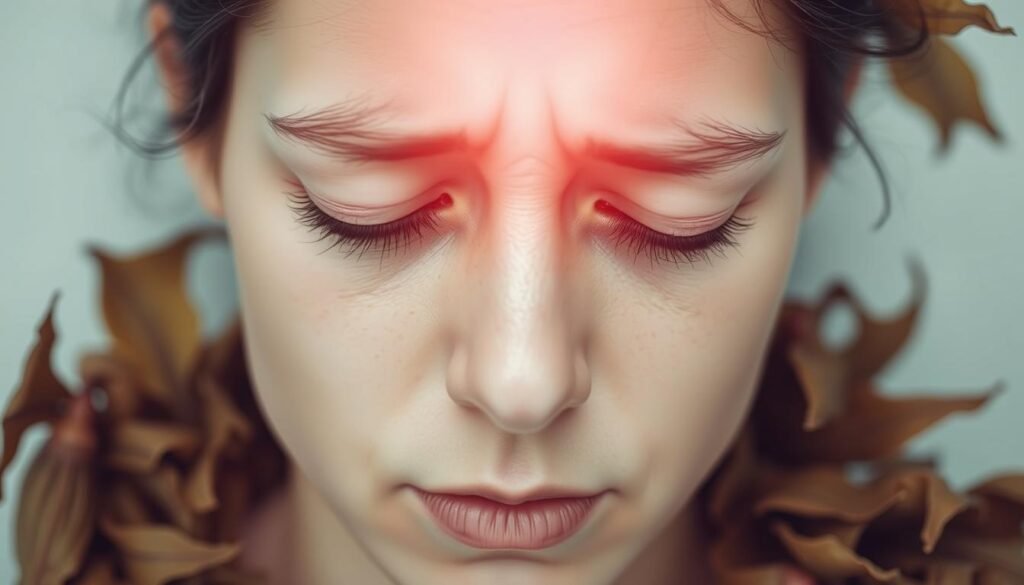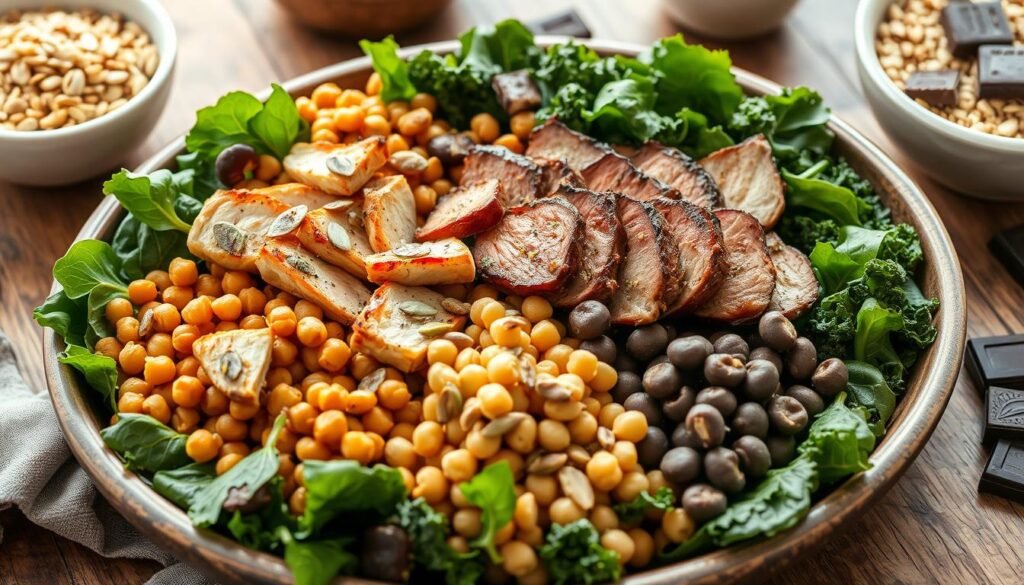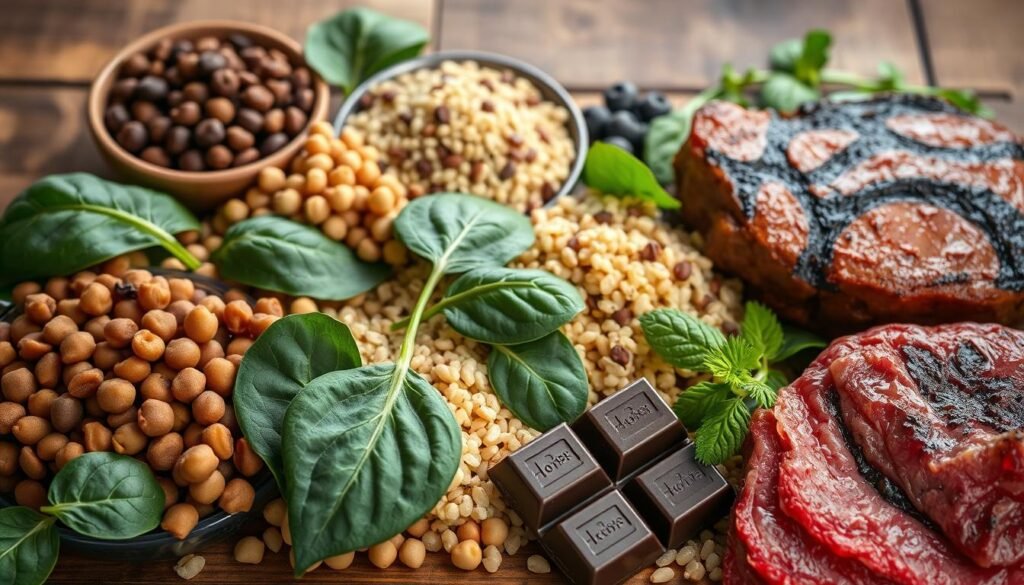Ever thought changing your diet could boost your energy and health? Anemia makes you tired because you don’t have enough iron. Eating foods high in iron is key to fighting anemia.
Foods rich in iron can significantly increase your iron levels. This includes hemoglobin-boosting foods and tips for better iron uptake. For those looking for anemia solutions, this article offers valuable advice. For more on iron’s role, check out this source.
Key Takeaways
- Anemia results from inadequate iron, impacting overall energy and health.
- Dietary adjustments can play a vital role in improving iron levels.
- Iron-rich foods can be sourced from both animal and plant-based origins.
- Vitamin C enhances iron absorption, making it crucial for an effective anemia diet.
- Understanding sources and absorption strategies helps combat anemia effectively.
Understanding Anemia and Its Causes
Anemia is a condition where your body lacks enough red blood cells or hemoglobin. This leads to less oxygen moving around your body. It is important to understand anemia well to treat and manage it effectively. Knowing what causes anemia, like poor nutrition or health problems, is key.
Iron deficiency is a major cause of anemia. Iron is needed to make hemoglobin, and not having enough causes a drop in healthy red blood cells. Lack of vitamin B12 and folate is another big problem. These vitamins help create and mature red blood cells. So, not getting enough of them through diet or not absorbing them well can increase anemia risk.
Chronic illnesses such as kidney problems or inflammation can also lower red blood cell production. For women, anemia might come from losing blood during periods or when giving birth. By understanding these causes of anemia, doctors can better diagnose it. This allows for dietary changes to be made to help.
Symptoms of Anemia
Spotting anemia is about noticing certain key signs. Common symptoms of anemia include many physical indicators that can impact your day-to-day life. Fatigue is a major sign, often making people feel constantly tired.
Additional signs of anemia include:
- Pale or jaundiced skin
- Dizziness or lightheadedness
- Shortness of breath, especially during exercise
- Irregular heartbeats or increased heart rate
- Cold hands and feet from not enough blood flow
Knowing these symptoms helps you get advice from doctors early. It’s important to have a doctor check why you have anemia. They can figure out the cause and how to fix it. This step is key in taking care of your health and making the right changes to your diet to help with anemia.

It’s crucial to know the different signs of anemia for early help. Being aware lets you act fast to stop the symptoms from getting worse. This means you can get better and feel more energetic sooner.
Dietary Adjustments to Combat Anemia
Iron is crucial for our health, especially if you have anemia. This mineral is needed to make hemoglobin. Hemoglobin carries oxygen around the body. Without enough iron, you may feel tired and weak. So, adding iron-rich foods to your diet is key.
Importance of Iron in the Diet
Iron is vital for our bodies, affecting many functions like energy production. How much iron you need changes with age, sex, and health status. For instance, men usually need 8 mg of iron, while women often need 18 mg. Eating the right iron sources can fight anemia.
Role of Vitamin C in Iron Absorption
Vitamin C helps our bodies absorb iron from plants better. Eating foods high in vitamin C with iron-rich foods boosts iron levels. Knowing how vitamin C and iron work together is useful for improving your iron intake.
| Demographic | Recommended Daily Allowance (mg) |
|---|---|
| Adult Men | 8 |
| Adult Women (Ages 19-50) | 18 |
| Pregnant Women | 27 |
| Children (Ages 1-3) | 7 |
| Children (Ages 4-8) | 10 |
By following these guidelines, you can better manage your iron levels. This helps in fighting anemia. For more on improving your iron intake, visit here.
Iron-Rich Foods for Anemia
Eating balanced meals is key to handling anemia. This means eating plenty of foods rich in iron. It’s important to know the difference between iron from animals and plants for better absorption. Mixing both kinds in your diet is a great strategy.
Animal Sources of Iron
Animal-based iron comes mainly from heme iron, which our bodies can use easily. Foods like beef, chicken thighs, and seafood are packed with it. These have a kind of iron that your body can absorb quickly.
- Red meats such as beef and lamb
- Poultry, particularly dark meat like chicken thighs
- Fish and seafood, including shellfish like oysters and clams
Adding these iron-rich foods to your diet can raise your iron levels fast. They’re especially good for those fighting anemia.
Plant-Based Iron Sources
Plants have non-heme iron, which isn’t absorbed as easily. But they’re still crucial, especially for vegetarians. Foods rich in plant-based iron include lentils and spinach.
- Lentils
- Beans and legumes
- Tofu and tempeh
- Quinoa
- Nuts and seeds
- Dark leafy greens, such as spinach and kale
To help your body use the iron from plants, eat them with vitamin C-rich foods. Oranges, strawberries, and bell peppers are great choices. This combo helps increase iron absorption.

| Food Type | Iron Type | Example Foods |
|---|---|---|
| Animal Sources | Heme Iron | Beef, chicken, fish |
| Plant Sources | Non-Heme Iron | Lentils, spinach, quinoa |
Foods to Help Anemia
Eating foods rich in iron and vitamins can help combat anemia. Foods like anemia-fighting foods are key for good health. They help the body make red blood cells.

- Fortified Cereals: Many breakfast cereals are enriched with iron. They are an easy way to get more iron.
- Nuts and Seeds: Almonds, pumpkin seeds, and sunflower seeds are full of healthy fats and iron.
- Leafy Greens: Spinach, kale, and collard greens offer a lot of iron and vitamins.
- Beans and Legumes: Lentils, chickpeas, and black beans are great for iron and protein. They are good for nutrition for anemia.
- Lean Meat: Chicken and turkey provide heme iron. This kind of iron is easily used by the body.
- Seafood: Clams, oysters, and sardines are full of nutrients and iron.
- Vitamin C-Rich Foods: Citrus fruits, strawberries, and bell peppers help the body absorb iron. They are good for fighting anemia.
Adding a mix of these foods to your diet helps with anemia. For detailed diet tips, read this guide. It has advice on creating a diet plan for better health.
| Food Group | Examples | Key Nutritional Benefits |
|---|---|---|
| Fortified Cereals | Special K, Cheerios | Iron, B vitamins |
| Nuts and Seeds | Almonds, pumpkin seeds | Iron, magnesium |
| Leafy Greens | Spinach, kale | Iron, vitamin A |
| Beans and Legumes | Lentils, chickpeas | Iron, fiber |
| Lean Meat | Chicken, turkey | Heme iron, protein |
| Seafood | Clams, sardines | Iron, omega-3 fatty acids |
| Vitamin C-Rich Foods | Oranges, strawberries | Facilitates iron absorption |
Choosing colorful, nutrient-filled foods helps people with anemia. It makes meals enjoyable. And it boosts their iron levels and overall health.
Best Diet for Anemia: Meal Planning Tips
Effective meal planning is key in fighting anemia. It’s all about choosing iron-rich foods for your menu. When you plan your meals right, you make sure each one has iron. This is crucial for tackling anemia.
Incorporating Iron-Rich Foods into Daily Meals
Here are some tips to get more iron from your meals:
- Start the Day Right: Begin with breakfasts like oatmeal with nuts or seeds. Drink orange juice with it to help your body absorb the iron better.
- Nutritious Lunch Options: For lunch, try a salad with spinach, chickpeas, and chicken. Add lemon juice to help take in more iron.
- Hearty Dinners: For dinner, dishes like quinoa-stuffed peppers or lentil stew are perfect. They’re rich in iron and other key nutrients.
- Smart Snacking: Snack on hummus with whole-grain pita or dried fruits like apricots. They keep your energy and iron up during the day.
Switching up these meals keeps your diet interesting and balanced. Eating a variety of foods helps your body absorb iron better. This keeps you healthy.
Preventing Anemia Through Diet
Diet plays a key role in preventing anemia. It’s vital to know which foods might lower your iron levels. By choosing what to eat wisely, you can maintain your health better.
Foods to Avoid for Optimal Iron Levels
It’s crucial to know which foods can harm your iron absorption when working on anemia prevention. Here are some food categories you should eat less of:
- Dairy Products: They’re high in calcium which can block iron from being absorbed. Try to eat them at different times than iron-rich foods.
- Beverages Containing Tannins: Tea and coffee have tannins. Tannins can latch onto iron, making it hard for your body to get what it needs. It’s best to not drink these with meals.
- Whole Grains and Certain Legumes: These can also stop iron from being absorbed due to their high phytate content. If you soak or sprout them before eating, it helps a lot.
How you combine foods matters too. Eating foods rich in vitamin C with iron-rich foods boosts absorption. It helps even when you eat foods that usually block iron. For more tips on eating right to fight anemia, check out this helpful site.
| Food Type | Components Affecting Iron Absorption | Suggested Changes |
|---|---|---|
| Dairy Products | Calcium | Consume between meals |
| Tea/Coffee | Tannins | Avoid at mealtime |
| Whole Grains | Phytates | Soak or sprout before cooking |
Conclusion
To sum up the advice on beating anemia with diet, it’s obvious that smart food choices boost iron levels. Everyone, especially women who can have children, should eat more foods high in iron. They should also know that vitamin C helps the body absorb iron better.
Changing what you eat is crucial for good health. Eating both meat and plant foods rich in iron can stop iron deficiency anemia. Making these healthy food choices is key to feeling great all around.
Before you change your diet a lot, talking to a doctor or nutritionist is smart. They can offer tailored advice to make sure the new eating plan works and keep an eye on your health improvements. If you want to dive deeper into how nutrition affects iron levels, check out this resource. Learn more about effective dietary strategies for fighting anemia.